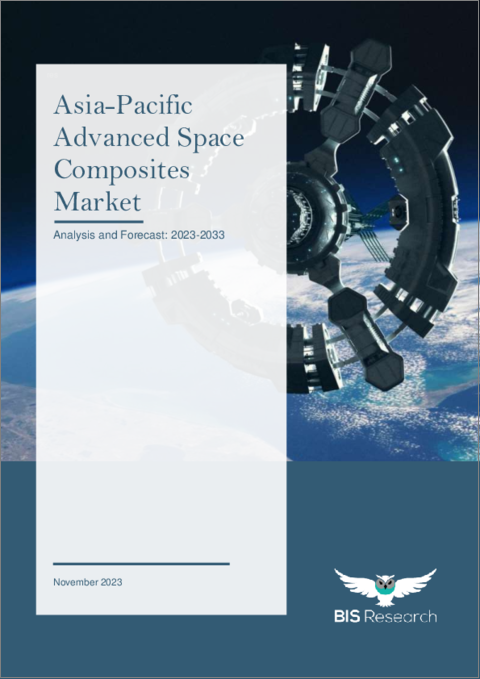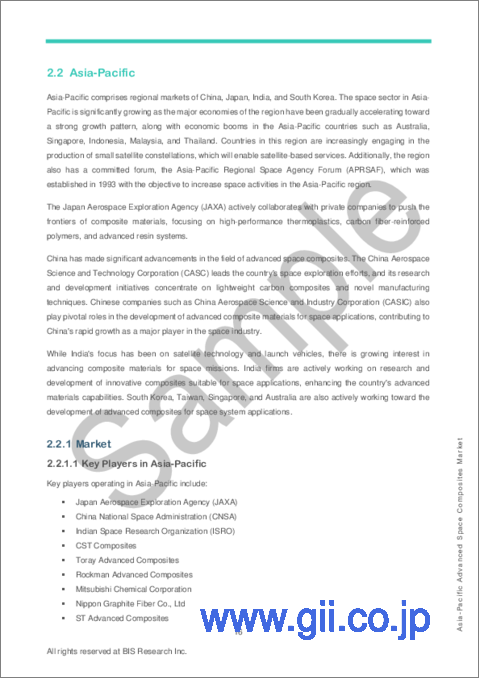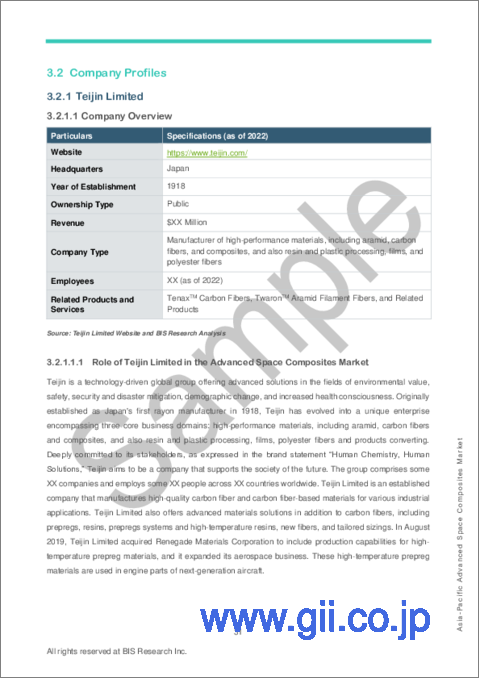|
|
市場調査レポート
商品コード
1374895
アジア太平洋地域の先進宇宙複合材料市場:2023-2033年Asia-Pacific Advanced Space Composites Market - Analysis and Forecast, 2023-2033 |
||||||
カスタマイズ可能
|
|||||||
| アジア太平洋地域の先進宇宙複合材料市場:2023-2033年 |
|
出版日: 2023年11月02日
発行: BIS Research
ページ情報: 英文 70 Pages
納期: 1~5営業日
|
- 全表示
- 概要
- 図表
- 目次
アジア太平洋地域の先進宇宙複合材料の市場は、2022年の2億6,000万米ドルから、予測期間中は12.38%のCAGRで推移し、2033年には9億5,000万米ドルの規模に成長すると予測されています。
アジア太平洋地域の航空宇宙産業では、先進宇宙複合材料の市場が重要なセクターとして急速に重要性を増しています。衛星技術と宇宙探査を一変させる強靭で軽量な素材へのニーズの高まりが、この拡大を後押ししています。
当レポートでは、アジア太平洋地域の先進宇宙複合材料の市場を調査し、市場概要、市場成長への各種影響因子の分析、法規制環境、市場規模の推移・予測、各種区分・主要国別の詳細分析、競合情勢、主要企業の分析などをまとめています。
アジア太平洋地域の先進宇宙複合材料市場:イントロダクション
| 主要市場統計 | |
|---|---|
| 予測期間 | 2023-2033年 |
| 2023年評価 | 3億米ドル |
| 2033年予測 | 9億5,000万米ドル |
| CAGR | 12.38% |
市場区分
セグメント1:プラットフォーム別
- 人工衛星
- 打ち上げロケット
- 深宇宙探査機・ローバー
セグメント2:コンポーネント別
- ペイロード
- 構造物
- アンテナ
- 太陽電池パネル
- 推進剤タンク
- 宇宙船モジュール
- サンシェードドア
- スラスター
- 熱保護
セグメント3:素材別
- 炭素繊維
- ガラス繊維
- 熱硬化性
- 熱可塑性
- ナノ材料
- セラミックマトリックス複合材料 (CMC)・金属マトリックス複合材料 (MMC)
- その他
セグメント4:製造プロセス別
- 自動ファイバープレースメント (ATL/AFP)
- 圧縮成形
- 積層造形
- その他
セグメンテーション5:地域別
- アジア太平洋地域:中国、日本、インド、その他
主要企業:
|
|
目次
第1章 市場
- 業界の展望
- 先進宇宙複合材料市場:概要
- サプライチェーン分析
第2章 アジア太平洋
- 世界の先進宇宙複合材料市場 (地域別)
- アジア太平洋
- 市場
- 用途
- 製品
- アジア太平洋 (国別)
第3章 競合ベンチマーキング・企業プロファイル
- 競合ベンチマーキング
- 企業プロファイル
- 打ち上げロケットおよび衛星メーカー
- その他の主要企業プロファイル
第4章 調査手法
List of Figures
- Figure 1: Asia-Pacific Advanced Space Composites Market, $Billion, 2023 and 2033
- Figure 2: Asia-Pacific Advanced Space Composites Market (by Platform), $Billion, 2023 and 2033
- Figure 3: Asia-Pacific Advanced Space Composites Market (by Component), $Billion, 2023 and 2033
- Figure 4: Asia-Pacific Advanced Space Composites Market (by Material), $Billion, 2023 and 2033
- Figure 5: Asia-Pacific Advanced Space Composites Market (by Region), $Billion, 2033
- Figure 6: Supply Chain Analysis
- Figure 7: Advanced Space Composite Market, Competitive Benchmarking
- Figure 8: Research Methodology
- Figure 9: Top-Down and Bottom-Up Approach
- Figure 10: Assumptions and Limitations
List of Tables
- Table 1: Advanced Space Composites Market (by Region), $Billion, 2022-2033
- Table 2: Asia-Pacific Advanced Space Composites Market (by Platform), $Billion, 2022-2033
- Table 3: Asia-Pacific Advanced Space Composites Market (by Component), $Billion, 2022-2033
- Table 4: Asia-Pacific Advanced Space Composites Market (by Material), $Billion, 2022-2033
- Table 5: Asia-Pacific Advanced Space Composites Market (by Manufacturing Process), $Billion, 2022-2033
- Table 6: China Advanced Space Composites Market (by Platform), $Billion, 2022-2033
- Table 7: China Advanced Space Composites Market (by Material), $Billion, 2022-2033
- Table 8: Japan Advanced Space Composites Market (by Platform), $Billion, 2022-2033
- Table 9: Japan Advanced Space Composites Market (by Material), $Billion, 2022-2033
- Table 10: India Advanced Space Composites Market (by Platform), $Billion, 2022-2033
- Table 11: India Advanced Space Composites Market (by Material), $Billion, 2022-2033
- Table 12: Rest-of-Asia-Pacific Advanced Space Composites Market (by Platform), $Billion, 2022-2033
- Table 13: Rest-of-Asia-Pacific Advanced Space Composites Market (by Material), $Billion, 2022-2033
- Table 14: Teijin Limited: Product Portfolio
- Table 15: Teijin Limited: Acquisition
- Table 16: ArianeGroup: Ongoing and Planned Programs/Projects
- Table 17: Blue Origin: Ongoing and Planned Programs/Projects
- Table 18: Boeing: Ongoing and Planned Programs/Projects
- Table 19: Firefly Aerospace: Ongoing and Planned Programs/Projects
- Table 20: Lockheed Martin: Ongoing and Planned Programs/Projects
- Table 21: MDA Space: Ongoing and Planned Programs/Projects
- Table 22: Northrop Grumman: Ongoing and Planned Programs/Projects
- Table 23: Rocket Lab, Inc.: Ongoing and Planned Programs/Projects
- Table 24: SpaceX: Ongoing and Planned Programs/Projects
- Table 25: Thales Alenia Space: Ongoing and Planned Programs/Projects
- Table 26: Other Key Player Profiles
“The Asia-Pacific Advanced Space Composites Market Expected to Reach $0.95 billion, by 2033 at CAGR of 12.38%.”
Introduction to Asia-Pacific Advanced Space Composites Market
| KEY MARKET STATISTICS | |
|---|---|
| Forecast Period | 2023 - 2033 |
| 2023 Evaluation | $0.30 Billion |
| 2033 Forecast | $0.95 Billion |
| CAGR | 12.38% |
The Asia-Pacific advanced space composites market is projected to reach $0.95 billion by 2033 from $0.26 billion in 2022, growing at a CAGR of 12.38% during the forecast period 2023-2033.
In the Asia-Pacific (APAC) aerospace industry, the advanced space composites market is growing quickly in importance as a critical sector. The growing need for strong, lightweight materials that can transform satellite technology and space exploration is driving this expansion. Composites are a class of materials that mix several elements to provide superior mechanical, thermal, and structural qualities. These materials are creating new opportunities to improve the performance and efficiency of space systems.
Market Introduction
The Advanced Space Composites Market is expanding and changing quickly within the aerospace industry, which is seeing the Asia-Pacific (APAC) region emerge as a dynamic and significant player in the world stage. Advanced space composites are transforming space exploration, satellite technology, and numerous aerospace initiatives around the APAC region. These materials are created for excellent strength-to-weight ratios, exceptional endurance, and flexible uses.
Market Segmentation:
Segmentation 1: by Platform
- Satellites
- Launch Vehicles
- Deep Space Probes and Rovers
Segmentation 2: by Component
- Payloads
- Structures
- Antenna
- Solar Array Panels
- Propellent Tanks
- Spacecraft Module
- Sunshade Door
- Thrusters
- Thermal Protection
Segmentation 3: by Material
- Carbon Fiber
- Glass Fiber
- Thermoset
- Thermoplastic
- Nanomaterials
- Ceramic Matrix Composites (CMC) and Metal Matrix Composites (MMC)
- Others
Segmentation 4: by Manufacturing Process
- Automated Fiber Placement (ATL/AFP)
- Compression Molding
- Additive Manufacturing
- Others
Segmentation 5: by Region
- Asia-Pacific - China, Japan, India, and Rest-of-Asia-Pacific
Key Drivers
One of the main factors propelling the APAC Advanced Space Composites Market is the increasing need for materials that are both lightweight and very durable. These materials are essential for contemporary space applications since they provide unmatched chances to improve the effectiveness and capacities of space borne equipment.
How can this report add value to an organization?
Product/Innovation Strategy: The product segment helps the reader to understand the different types of solutions available for deployment and their potential globally. Moreover, the study provides the reader with a detailed understanding of the APAC advanced space composites market by technology, inclusive of the key developments in the respective segments globally.
Growth/Marketing Strategy: The APAC advanced space composites market has seen some major development by key players operating in the market, such as partnership, collaboration, and joint venture. The favored strategy for the collaboration between government space agencies and private players is primordially contracting the development and delivery of advanced materials and specialized composite components for space system applications.
Competitive Strategy: Key players in the APAC advanced space composites market have been analyzed and profiled in the study, inclusive of major segmentations and service offerings companies provide in the technology segments, respectively. Moreover, a detailed competitive benchmarking of the players operating in the APAC advanced space composites market has been done to help the reader understand how players stack against each other, presenting a clear market landscape. Additionally, comprehensive competitive strategies such as partnerships, agreements, and collaborations will aid the reader in understanding the revenue pockets in the market.
Methodology: The research methodology design adopted for this specific study includes a mix of data collected from primary and secondary data sources. Both primary resources (key players, market leaders, and in-house experts) and secondary research (a host of paid and unpaid databases), along with analytical tools, are employed to build the predictive and forecast models.
Data and validation have been taken into consideration from both primary sources as well as secondary sources.
Key players operating in Asia-Pacific include:
|
|
Table of Contents
1 Markets
- 1.1 Industry Outlook
- 1.1.1 Advanced Space Composites Market: Overview
- 1.1.2 Supply Chain Analysis
2 Asia-Pacific
- 2.1 Global Advanced Space Composites Market (by Region)
- 2.2 Asia-Pacific
- 2.2.1 Market
- 2.2.1.1 Key Players in Asia-Pacific
- 2.2.1.2 Business Driver
- 2.2.1.3 Business Challenge
- 2.2.2 Application
- 2.2.2.1 Asia-Pacific Advanced Space Composites Market (by Platform)
- 2.2.2.2 Asia-Pacific Advanced Space Composites Market (by Component)
- 2.2.3 Product
- 2.2.3.1 Asia-Pacific Advanced Space Composites Market (by Material)
- 2.2.3.2 Asia-Pacific Advanced Space Composites Market (by Manufacturing Process)
- 2.2.4 Asia-Pacific (by Country)
- 2.2.4.1 China
- 2.2.4.1.1 Market
- 2.2.4.1.1.1 Key Players in China
- 2.2.4.1.2 Application
- 2.2.4.1.2.1 China Advanced Space Composites Market (by Platform)
- 2.2.4.1.3 Product
- 2.2.4.1.3.1 China Advanced Space Composites Market (by Material)
- 2.2.4.1.1 Market
- 2.2.4.2 Japan
- 2.2.4.2.1 Market
- 2.2.4.2.1.1 Key Players in Japan
- 2.2.4.2.2 Application
- 2.2.4.2.2.1 Japan Advanced Space Composites Market (by Platform)
- 2.2.4.2.3 Product
- 2.2.4.2.3.1 Japan Advanced Space Composites Market (by Material)
- 2.2.4.2.1 Market
- 2.2.4.3 India
- 2.2.4.3.1 Market
- 2.2.4.3.1.1 Key Players in India
- 2.2.4.3.2 Application
- 2.2.4.3.2.1 India Advanced Space Composites Market (by Platform)
- 2.2.4.3.3 Product
- 2.2.4.3.3.1 India Advanced Space Composites Market (by Material)
- 2.2.4.3.1 Market
- 2.2.4.4 Rest-of-Asia-Pacific
- 2.2.4.4.1 Application
- 2.2.4.4.1.1 Rest-of-Asia-Pacific Advanced Space Composites Market (by Platform)
- 2.2.4.4.2 Product
- 2.2.4.4.2.1 Rest-of-Asia-Pacific Advanced Space Composites Market (by Material)
- 2.2.4.4.1 Application
- 2.2.4.1 China
- 2.2.1 Market
3 Competitive Benchmarking and Company Profiles
- 3.1 Competitive Benchmarking
- 3.2 Company Profiles
- 3.2.1 Teijin Limited
- 3.2.1.1 Company Overview
- 3.2.1.1.1 Role of Teijin Limited in the Advanced Space Composites Market
- 3.2.1.1.2 Product Portfolio
- 3.2.1.2 Corporate Strategies
- 3.2.1.2.1 Acquisition
- 3.2.1.3 Analyst View
- 3.2.1.1 Company Overview
- 3.2.2 Sample Company
- 3.2.2.1 Overview
- 3.2.2.2 Top Products / Product Portfolio
- 3.2.2.3 Top Competitors
- 3.2.2.4 Target Customers
- 3.2.2.5 Key Personnel
- 3.2.2.6 Analyst View
- 3.2.2.7 Market Share
- 3.2.3 Sample Company
- 3.2.3.1 Overview
- 3.2.3.2 Top Products / Product Portfolio
- 3.2.3.3 Top Competitors
- 3.2.3.4 Target Customers
- 3.2.3.5 Key Personnel
- 3.2.3.6 Analyst View
- 3.2.3.7 Market Share
- 3.2.4 Sample Company
- 3.2.4.1 Overview
- 3.2.4.2 Top Products / Product Portfolio
- 3.2.4.3 Top Competitors
- 3.2.4.4 Target Customers
- 3.2.4.5 Key Personnel
- 3.2.4.6 Analyst View
- 3.2.4.7 Market Share
- 3.2.5 Sample Company
- 3.2.5.1 Overview
- 3.2.5.2 Top Products / Product Portfolio
- 3.2.5.3 Top Competitors
- 3.2.5.4 Target Customers
- 3.2.5.5 Key Personnel
- 3.2.5.6 Analyst View
- 3.2.5.7 Market Share
- 3.2.6 Sample Company
- 3.2.6.1 Overview
- 3.2.6.2 Top Products / Product Portfolio
- 3.2.6.3 Top Competitors
- 3.2.6.4 Target Customers
- 3.2.6.5 Key Personnel
- 3.2.6.6 Analyst View
- 3.2.6.7 Market Share
- 3.2.7 Launch Vehicle and Satellite Manufacturers
- 3.2.7.1 ArianeGroup
- 3.2.7.2 Blue Origin
- 3.2.7.3 Boeing
- 3.2.7.4 Firefly Aerospace
- 3.2.7.5 Lockheed Martin
- 3.2.7.6 MDA Space
- 3.2.7.7 Northrop Grumman
- 3.2.7.8 Rocket Lab, Inc.
- 3.2.7.9 SpaceX
- 3.2.7.10 Thales Alenia Space
- 3.2.8 Other Key Player Profiles
- 3.2.1 Teijin Limited
4 Research Methodology
- 4.1 Factors for Data Prediction and Modeling






